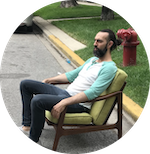My Adobe Premiere workflow for editing improvised scenes
I’ve been editing the first episode of my web series, Words Fail Me. The actors have a set of circumstances that they know in advance but all of the dialogue is improvised. It’s the first improvised video I’ve had to edit and it’s taken me a while to figure out a workflow that makes sense and isn’t insanely time-consuming.
I should say that this is the first time I’ve done this and that I’m still very new to editing in general, so your mileage may vary. But I’m putting it out there in case it helps someone.
With a scripted scene, you usually have 3-5 takes of the scene for each shot (wide, medium, CU, etc.). So basically the editing is about telling a predefined story using the different shots. But with this shoot, I had a general idea of where I wanted things to go, but the actor had a lot of input and free reign, within the basic constraints that I had laid out. All of that is to say that what we ended up with, story-wise, was a bit messy.
For this episode, we did a wide shot (without sound), a master (medium shot), and a CU. We did a few takes of the medium and CU, but there was no script and the dialogue changed. After each take, we took the parts of the story that we liked and emphasized those moving forward, but we didn’t make an effort to repeat the dialogue verbatim. The story beats stayed the same, but the dialogue changed. The beats within any given take also tended to change–some takes only had a few of the major story beats and they were often in a different order.
That’s challenging to edit because each take is a little different. With 45 minutes of footage, I would have to spend a lot of time searching for what I needed. So, I came up with a solution to break the process into smaller chunks and make it more manageable.
Here’s what I did to simplify the process:
- I reviewed the footage to get a general sense of how I wanted to structure the story (while putting together the trailer).
- In Word, I wrote an outline for the story, sketching out nine beats for the story, and then created sequences in Premiere for each story beat.
- I dragged all the clips onto the timeline and went through all of them, cutting them up into chunks that related to the various beats. If the first two minutes of a clip were related to beat 1, I would cut and paste that part of the clip to the Beat 1 sequence, and so on.
- By the end, I had nine sequences (one for each beat of the story) with five to six clips related to that beat. These were much more manageable chunks to work with (3-7 minutes each). I edited each of these sequences individually to come up with the best possible version of each beat.
- Once I had all nine beats the way I wanted them, I put them all on a master sequence and connected them.
- Finally, I massaged the master sequence to get it to work together smoothly, using the wide shot as a cutaway for any moments where I wanted the dialogue but didn’t want to use the video.1
The nice thing about working this way is that it separates three distinct tasks (‘writing’ the story, searching/organizing the footage, and crafting the actual edit to tell the story) into separate chunks so you don’t have to switch between cognitive modes. This freed my brain up to focus on one thing at a time. And it forced me to figure out how I wanted to tell the story before I started any of the actual editing.
Again, I’m new to this. YMMV. And please contact me if you know a better way or have any tips!
I wish we had shot more b-roll because it would’ve this easier and created some diversity in the imagery. Lesson learned. ↩
